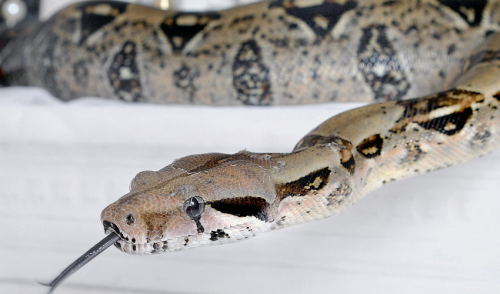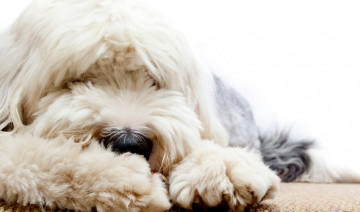A boa constrictor can be an amazing pet for any reptile or snake enthusiast, but they do require proper care to live healthy, safe lives. If you are considering a boa constrictor as a pet, be sure you can meet their needs before you adopt your new family member.
About Boa Constrictors
These large, heavy snakes are native to South America and parts of the Caribbean, and are found in a range of habitats from dense tropical rainforests to semi-arid, desert-like conditions. Most boa constrictors are happiest in tropical conditions with adequate humidity, and snake keepers need to be prepared to provide that type of habitat. Boas do climb, especially when young, but mature snakes are more terrestrial and do not need extensive climbing options. These are nocturnal snakes and are more active at night, and rest and bask during the day.
Boa constrictors range in size but can be 5-10 feet long when mature, which requires larger housing. They can live 25-30 years, and pet owners need to be prepared for that lifetime commitment. With superior care and excellent living conditions, some pet boa constrictors have lived as long as 40 years or more.
Most boa constrictors available in the pet trade are captive-bred animals, which generally have more docile temperaments than wild-caught snakes. Captive-bred snakes are preferred, not only because they are more accustomed to enclosures and human contact, but also because their personal history is known and their health condition can be more easily verified.
Meeting Your Pet Boa Constrictor’s Needs
Good care is essential to keep a boa constrictor healthy and content, to maximize the snake’s growth potential, and to give it a long lifespan. When planning for your boa constrictor, consider…
- Enclosure Size: Young, small boa constrictors can be happy in a large aquarium setup, but as the snakes grow they will need larger enclosures with at least 10 square feet of floorspace. Good housing for a large, mature boa constrictor will be at least 6-8 feet long and 2-3 feet high and wide so the snake has plenty of space.
- Enclosure Strength: These powerful snakes can be amazing escape artists. Simply weighting down a cover may be temporarily adequate to keep young boa constrictors from getting out, but a locking cover is highly recommended, particularly for older, larger snakes. Simple hooks or catches can easily keep a cover in place to prevent the snake’s escape.
- Privacy: Like all pets, boas need a private place to retreat when they feel stressed or frightened. Hides can be simple boxes with an entrance hole in the side, or more elaborate tunnels or hollow logs can be good options. The hide size should be slightly larger than the snake so it is a cozy niche the snake can curl up in for security. Each enclosure should have 2-3 hides available, including one on the warmer side of the cage and one on the cooler side.
- Temperature: These snakes prefer habitats that range from 82-90 degrees during the day and only drop to 78-85 degrees at night. A warmer basking area that ranges from 90-100 degrees is also necessary to help these reptiles regulate their body temperatures, but take care that no heating elements are exposed as boa constrictors can be easily susceptible to burns. Use a thermometer to monitor the enclosure’s temperature, and be sure one side is warm and one side is cool so the snake can move about to the temperature it prefers.
- Humidity: The tropical habitats where boa constrictors are native are often very humid, and a pet snake’s habitat should have 60-70 percent humidity. Use a humidity monitor to keep track of the air’s moisture. A wide, shallow bowl of water in the tank can help provide humidity, and these snakes enjoy regular misting, particularly during the summer months.
- Flooring: The enclosure’s substrate must be comfortable for the snake as well as easy to clean. Paper and paper towels are suitable for young snakes, while indoor/outdoor carpeting is a great option for a larger enclosure and older snake. Wood chips can be used but should be monitored carefully so they do not contaminate the snake’s food, which could cause internal injuries as the snake digests its meals.
- Perches: While mature boa constrictors are not frequent climbers, they will appreciate a large piece of driftwood or a sturdy branch for some enrichment. A few rocks can also be layered to create a climbing space for the snake to enjoy. Be sure all structures are clean and strong enough to support the snake’s weight without collapsing and potentially injuring the snake.
- Diet: These are carnivorous snakes and eat their prey whole. Smaller snakes eat mice, while larger, mature boas eat rats, rabbits, or even pigs. The prey should be no larger than the snake’s girth at the midpoint of its body to prevent choking or other digestive problems. Pre-killed prey is best, as live prey can bite or scratch the snake and cause skin infections or other injuries.
- Feeding Schedule: Boa constrictors do not need to eat daily. A young snake will need a meal every 5-7 days, while older snakes that eat larger prey may only feed once every 3-4 weeks. When a new snake is brought home, it should not be fed for at least 4-5 days to allow it to acclimate to its new habitat, otherwise it may not feed successfully or could regurgitate its meal. Similarly, snakes should not be handled for a day or two after being fed so they can fully digest their prey.
- Water: While these snakes do not drink extensively – they get the moisture they need from the blood of their prey – they will require a dish of water for occasional soaking to ease shedding. The water should be kept clean and fresh, and the dish should be washed regularly to prevent buildup of any feces or other debris.
- Handling: While boa constrictors are not strongly tactile pets, they can become accustomed to occasional handling and will enjoy sharing your body warmth. Regular gentle handling can also make your snake more accustomed to humans, which will make it easier when they must be handled to be moved or examined.
- Veterinary Care: Be sure you have access to a veterinarian with extensive reptile and snake experience. Discuss your boa constrictor’s needs with your vet and stay alert to any behavioral shifts, body condition changes, or other problems that may arise, and seek veterinary care immediately so any difficulties can quickly be resolved.
A boa constrictor can be a fun pet, but because of their extensive needs, they are best cared for by experienced reptile enthusiasts. Joining groups of other snake pet owners and snake hobbyists can help you learn even more about boas and how to welcome one into your home.


Comments